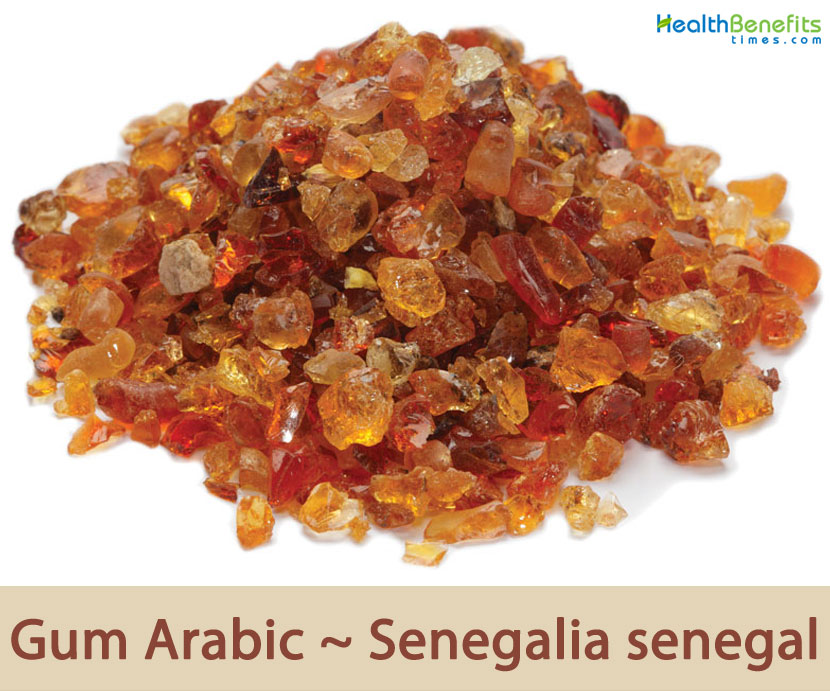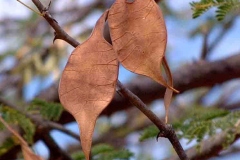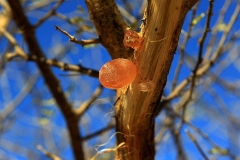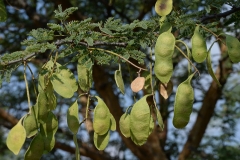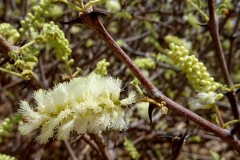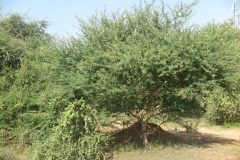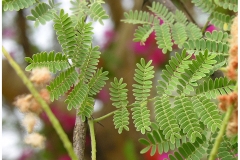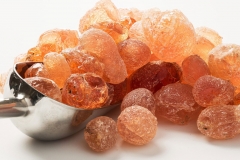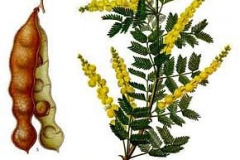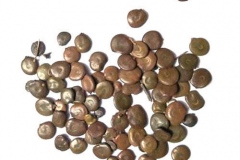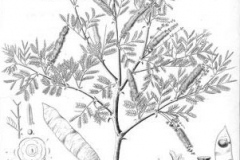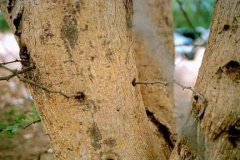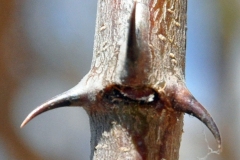The tree is the major source of the valuable gum ‘Gum Arabic’ and is commonly harvested from the wild and traded internationally. The tree is also an important local source of food additive, crafts, medicines, cosmetics and materials, being commonly harvested from the wild. The gum is drained from cuts in the bark, and an individual tree will yield 200 to 300 grams. Seventy percent of the world’s gum arabic is produced in Sudan. The harvested gum is dried and crushed into a fine powder, rich in complex polysaccharides, highly soluble in water, and mostly indigestible to both humans and animals. The gum is used for soothing mucous membranes of the intestine and to treat inflamed skin. It is also supposedly used as for its astringent properties, to treat bleeding, bronchitis, diarrhea, gonorrhea, leprosy, typhoid fever and upper respiratory tract infections. It is often grown in agroforestry and to preserve and improve the soil.
Gum Arabic Facts
| Gum Arabic Quick Facts | |
|---|---|
| Name: | Gum Arabic |
| Scientific Name: | Senegalia senegal |
| Origin | Western Sudan, Nigeria and the Arabian Peninsula |
| Colors | Yellowish to brown in color |
| Shapes | Straight or slightly curved dehiscent papery pod, re-trap-shaped, 7.5–18 cm long and 2.5 cm wide, thin, flat, papery or woody |
| Taste | Acrid, bitter |
| Health benefits | Reduces body fat, Excellent Source of Dietary Fiber, Promote Kidney Function, Relieves pain and irritation, Soothes coughs and sore throats, Lowers cholesterol, Helps wound healing, Encourages Weight Loss, Supports Liver Health, Helps Control Diabetes, Enhances Oral Health, Battle Oxidative Stress |
| Name | Gum Arabic |
|---|---|
| Scientific Name | Senegalia senegal |
| Native | Western Sudan, Nigeria and the Arabian Peninsula. It is commonly found in tropical areas of Western and Central Africa, and in Eastern Africa from Mozambique to South Africa. It was introduced into Egypt, Australia, Puerto Rico, the Virgin Islands, and South Asia. It is cultivated in India, Pakistan and Nigeria |
| Common Names | Gum acacia, Gum arabic tree, Senegal gum, and Sudan gum Arabic, acacia gum, arabic gum, acacia powder, Indian gum, Red talah, Three thorn acacia, kher, Three thirn acacia, gum-arabic acacia, three hook thorn |
| Name in Other Languages | Afrikaans: Driehaakdoring, Geelhaak, Gomdoring, Grievingerdoring Amharic: Kontir, Sbansa-girar Arabic : Adaab, samagh hashabun (صمغ هشاب), sint sinighali (سنط سنغالي) Sunt senghali , Alloba, Asharat, Hashab, Subahi, Temmar, Tur, Um gebala, simgh earabiun (صمغ عربي) Azerbaijani: Seneqal akasiyası Babbara: Dɔ̀nkɔri Bulgarian: Senegalska akatsiya (сенегалска акация) Chinese: A la bo jiao (阿拉伯胶 ), A la bo jiao shu (阿拉伯胶树), Sàinèijiā’ěr ér chá (塞内加尔儿茶) Czech: Akácie senegalská, Arabská guma Danish: Gummiakacie Dutch: Arabische gomboom, witte gomboom English: Gum-arabic, Gum-arabic-tree, Red talah, Senegal gum, Sudan gum-arabic, Three thorn acacia, kher, Three thirn acacia, gum-arabic acacia, three hook thorn Estonian: Kummiakaatsia French: Acacia à gomme, Acacia du senegal, Gommier blanc, acacia à gomme arabique, acacia à gomme du Sénégal German: Arabicumbaum, Arabisches Gummi, Dreidorn-Akazie, Gummibaum, Gummi-Akazie, Gummiarabikumbaum, Haschab der Nilländer, Senegal Akazie, Verek der Senegambier, Verek Akazie Gujarati: Goraduja baval, Kagar, Gōraḍa (ગોરડ) Hausa: Dakwara, Akora Hebrew: סנגליית סנגל Hindi: Goraduja baval, Humath, Kher (खेर), Khor, Kumat, Kumttha (कुम्ट्ठा), Safed khair, Chaar Gund, Goraduja baval, Humath, Kumatiyo, Kumatio Hungarian: Akáciamézga , Arabmézga , Arabmézgafa , Gumiakácia , Gumiarábikum, Szenegáli acacia Italian: Acacia del Senegal, albero gommifero Japanese: Arabiagomu (アラビアゴム), Arabiagomunoki (アラビアゴムノキ), Akashia senegaru (ア カシアセネガル ), Senegaru akashia (セネガルア カシア ), Arabiagamu (アラビアガム), Kore (これ) Kikuyu: Mu nyua Kinyarwanda: Umukonji Korean: Alabiagomunamu (아라비아고무나무) Marathi: Khair (खैर) Persian: آکاسیا سنگال , سنگالیا سنگال Polish: Guma arabska Portuguese: Acácia-da-goma-arábica, acácia-do-Senegal, goma-arábica Russian: Akatsiia senegal’skaia (Акация сенегальская), Akatsiia smolistaya (Акация смолистая), Senegalʹskoy akatsii (Сенегальской акации) Sanskrit: Śvetakhadira, Sneta khadira, Babul Somali: Cadaad Spanish: Acacia del Senegal, Gonahie del senegal , Gutagamba árabe, acacia Senegal, goma arábiga Swahili: Aitu, Kikwata,Mgunga Swedish: Gummiakacia, acacia Senegal Thai: Kạm xā rbik (กัม อารบิก ) Turkish: Arap zamkı Wolof: Wereg Zulu: IsiKhambophane, umKhala |
| Plant Growth Habit | Low-growing, small, thorny, deciduous shrub or small tree |
| Growing Climates | Dry scrub and wooded grassland |
| Soil | Thrives on rocky slopes and sandy soils, but also on clay plains and cotton soils |
| Plant Size | Grows about 5-12 m tall and 30 cm in trunk diameter, with a rounded canopy, short trunk, and low branches. |
| Bark | Yellowish brown to crimson black in color, rough or smooth, have a papyrus consistency and may be peeled apart in strips or heavily cracked and black in older trees |
| Leaf | Double-compound, 3.5 to 8 cm long, with 3 to 8 pairs of pinnae. The rachis (main stem of the compound leaf) sometimes bears prickles. The pinnae are 1.5 to 2.5 cm long with 5 to 25 pairs of leaflets per pinna. The leaflets are small, 1 to 9 mm long, 0.5 to 3 mm wide, rigid, leathery, linear to elliptic-oblong, sparsely hairy or smooth on both surfaces, tip blunt to somewhat pointed |
| Flowering season |
|
| Flower | Flowers are normally produced with the leaves. Sepal cup is bell-shaped, glabrous, deeply toothed. Flowers are white to yellowish, fragrant, stalk less. |
| Fruit Shape & Size | Straight or slightly curved dehiscent papery pod, re-trap-shaped, 7.5–18 cm long and 2.5 cm wide, thin, flat, papery or woody |
| Fruit Color | Yellowish to brown in color |
| Seed | Seeds are disc like, almost circular, ovate to linear-ovate, 6-9 mm long, 5-8 mm broad, with a U shaped depression on either side, smooth, dark brown to greyish green in color |
| Propagation | By seeds and by tissue culture |
| Taste | Acrid, bitter |
| Plant Parts Used | Gum |
| Season |
|
| Health Benefits |
|
Plant Description
Gum Arabic is a low-growing, small, thorny, deciduous shrub or small tree that normally grows about 5-12 m tall and 30 cm in trunk diameter, with a rounded canopy, short trunk, and low branches. Thorns are placed just below the nodes, either in threes up to 7 mm long, with the middle one hooked downwards and the lateral ones curved upwards, or solitary with the laterals absent. The bark may be yellowish brown and smooth in young trees, becoming dark grey, gnarled, rough or smooth, have a papyrus consistency and may be peeled apart in strips or heavily cracked in older trees. The treetop may be slightly rounded, flat and somewhat spread out or even spindly and frayed with branches of irregular sizes. The plant is found growing in dry scrub and wooded grassland. It thrives on rocky slopes and sandy soils, but also on clay plains and cotton soils.
Leaves
The leaves are double-compound, 3.5 to 8 cm long, with 3 to 8 pairs of pinnae. The rachis (main stem of the compound leaf) sometimes bears prickles. The pinnae are 1.5 to 2.5 cm long with 5 to 25 pairs of leaflets per pinna. The leaflets are small, 1 to 9 mm long, 0.5 to 3 mm wide, rigid, leathery, linear to elliptic-oblong, sparsely hairy or smooth on both surfaces, tip blunt to somewhat pointed.
Flowers
Flowers are borne in very dense cylindrical spikes 5–10 cm long, carried on stalks 0.7–2 cm long. Flowers are normally produced with the leaves. Sepal cup is bell-shaped, glabrous, deeply toothed. Flowers are white to yellowish, fragrant, stalk less. Flowering normally takes place around July–September in western Africa and from December–January (–April) in South Africa.
Fruits
Fertile flowers are followed by straight or slightly curved dehiscent papery pod, re-trap-shaped, 7.5–18 cm long and 2.5 cm wide, thin, flat, papery or woody. Fruits are initially green and pubescent when young, become a shiny bronze when matures. They consist of 3-6 smooth, flat shiny seeds. Seeds are disc like, almost circular, ovate to linear-ovate, 6-9 mm long, 5-8 mm broad, with a U shaped depression on either side, smooth, dark brown to greyish green in color. Fruits start ripening from end of November and early February in West Africa and in October in South Africa.
Health benefits of Gum Arabic
Listed below are some of the well-known health benefits of using Gum Arabic
1. Reduces body fat
Gum Arabic has the potential to keep your weight in a healthy range while also reducing your overall body fat. Research involving 120 women, 60 women took 30 grams per day of acacia gum for six weeks, while the other 60 took a placebo containing just 1 gram of pectin. Results concluded that women who took the acacia gum reduced their body mass index. Their body fat percentage was also reduced by over 2 percent.
2. Excellent Source of Dietary Fiber
Gum Arabic provides an excellent source of fiber with numerous benefits. Due to its high soluble fiber content it’s a versatile ingredient that can enrich the nutritional profile of food and beverages and is used in dietary supplements to support digestive health.
Diet rich in fiber are essential to the digestive process, by shortening the time food passes through the intestinal tract, increasing bulk and stool production, and preventing constipation. Fiber increases the sensation of satiety, decreasing calorie intake, which may help with weight management. Soluble dietary fibers may enable additional benefits including colonic fermentation stimulation and reduction of cholesterolemia.
3. Promote Kidney Function
Kidney failure is related with shortness in breathing, swelling, weakness, lethargy, and confusion. Gum Arabic can help inhibit oxidative stress and inflammation thus slowing down kidney damaging progression. Apart from that patients should also avoid drinking too much coffee or tea, drink 8 glasses of water a day, and be physically active.
4. Relieves pain and irritation
Gum Arabic has a naturally sticky texture. Materials with this property are often used to reduce irritation and inflammation. Gum has been shown to be particularly effective in easing stomach or throat discomfort.
5. Soothes coughs and sore throats
Gum Arabic is identified to relieve irritation and inflammation; it can also help control coughs. The properties of Gum Arabic allow it to be used in solutions to coat your throat and protect the mucus in your throat from irritation. Using acacia for coughs can keep your throat from becoming sore as well as ease or prevent symptoms, including losing your voice.
6. Lowers cholesterol
Gum Arabic consists of soluble dietary fibers that will bind to your cholesterol so it can’t be absorbed into your body through the intestines. The certain cholesterol will be eliminated from the body through the excretory system, keeping your cholesterol levels in check.
7. Helps wound healing
Gum Arabic is often used in topical treatments to help wounds heal. Doctors, scientists, and researchers believe that this effect may be due to alkaloids, glycosides, and flavonoids. In one study, a species of acacia known as Acacia caesia was tested on rats as part of a topical wound treatment. It led to faster wound healing than the standard treatment.
8. Encourages Weight Loss
Gum Arabic can delay digestion by absorbing water from the stomach and the intestinal tract to form a gel. This gel is responsible for the satiety feeling and preventing cravings in between meals. Acacia fiber prevents insulin influxes responsible for weight gain by decelerating glucose absorption.
9. Supports Liver Health
Animal-based research concluded that acacia fiber may help guard against liver damage caused by acetaminophen. Research found that treating mice with acacia fiber prior to administering acetaminophen helped protect their livers from the drug’s toxic effects. Acacia fiber may help combat liver damage by reducing oxidative stress.
10. Helps Control Diabetes
Foods rich in dietary fiber are well-known to regulate blood sugar levels in type 2 diabetic patients. Gum Arabic is an excellent source of dietary fiber and this strongly suggests its ability to control blood sugar levels in diabetic patients. Few researches authenticated the potential controlling capabilities of dietary fiber on diabetes and included renal benefits.
11. Enhances Oral Health
Gum Arabic can be used as herbal toothpaste in its powdered form without being too abrasive. In fact, research once recognized that it was used to clean and clear more than two-thirds of tooth plaque. Other studies have shown the effects acacia gum has on tooth mineralization and treatment of chronic periodontitis (serious gum infection).
12. Battle Oxidative Stress
When lots of free radicals come to our body, oxidative stress occurs. This can damage cells in our body and cause numerous diseases. According to research, acacia gum consists of antioxidants that fight free radicals. Along with eating healthy foods, Gum Arabic can help protect us against different illnesses.
Traditional uses and benefits of Gum Arabic
- Gum Arabic is used to treat sore throats, coughs, catarrh, dysentery, diarrhea, burns, leprosy, ophthalmia, hemorrhage, gonorrhea, and nodular leprosy.
- Gum obtained from the trunk has calming properties and forms a protective coating over inflamed tissue, reducing irritation and encouraging healing.
- It is also often added to proprietary mixtures used in the treatment of dysentery and diarrhea.
- Externally, it is used in the treatment of sores, burns and leprosy.
- Bark, leaves and gum consists of tannins and are used as an astringent to treat colds, ophthalmic, diarrhea and hemorrhages.
- Roots are used to treat dysentery, gonorrhea and nodular leprosy.
- Seeds consist of fat, which is used in medicine.
- Gum Arabic is favorable in providing relief in case of brain strokes like brain hemorrhage.
- It is a good herbal treatment for curing oral ailments like cavities, plaque (pale yellow layer formation on the teeth), infection in the gums and advanced bacterial growth.
- It relieves the irritation, pain and swelling in the throat and the mouth.
- It is effective in curbing respiratory infections like cough and cold.
- It helps in promoting effective digestion and keeps the digestive system and the person healthy.
- It is a good herbal treatment for nursing the problem of low blood pressure.
- It is beneficial in curing inflammation and healing skin problems like wounds, cuts, boils and bruises.
- It helps in counteracting infections and also guards the internal organs against infections.
- It is effective in lowering the body cholesterol.
- It is helpful in providing relief from loose motions and loose stool thus, curing the ailment of irritable bowel syndrome.
- It has been reportedly used for its astringent properties, to treat bleeding, bronchitis, typhoid fever and upper respiratory tract infections
Ayurvedic Health benefits of Gum Arabic
- Yellow Fever: Make a decoction of Gum Arabic. Strain. Drink 10 ml of it by adding 1 teaspoon of Honey. Have it twice a day until symptoms persist.
- Anemia: Take Gum Arabic, Purslane and Basil. Grind them together. Fry powder in equal quantity of Olive oil. Cool it. Soak it in Rose Water for one hour. Have one teaspoon thrice a day for a month.
- Diabetes: Prepare a fine powder of Black Cumin, Acacia Speciosa seeds, Bitter Apple and Gum Arabic in the same quantity and store them in a vessel. Fill full size capsules and take four capsules a day. This is highly beneficial and trial prescription for Diabetes.
Culinary Uses
- Gum obtained from the trunk is important in the food industry, where it is used as an emulsifier, stabilizer and flavor fixative.
- It is also used as an additive (E414) that retards the crystallization of sugar.
- It is found especially in products such as chewing gum and confectionery.
- Dried seed is cooked as a protein source.
- In confectionery, gum Arabic is used to prevent crystallization of sugar, as an emulsifier, and as a glaze or topping in bakery products; in soft drinks and alcoholic drinks it is used either as a vehicle for flavoring or as a stabilizer or clouding agent; in frozen dairy products gum Arabic is used for encapsulating flavors such as citrus oils.
Different Uses
The use of gum arabic, which is derived from an exudate from the bark, dates from the first Egyptian Dynasty (3400 B.C.). It was used in the production of ink, which was made from a mix of carbon, gum and water. Inscriptions from the 18th Dynasty refer to gum as ‘komi’ or ‘komme’. Gum Arabic has been used for at least 4,000 years by local people for the preparation of food, in human and veterinary medicine, in crafts, and as a cosmetic. It produces the only acacia gum evaluated toxicologically as a safe food additive.
Nowadays the gum is present in a wide range of everyday products. 60-75% of the world production of gum Arabic is used in the food industry and in human and animal medicine.
Food
In the food industry gum Arabic is used as a flavor fixative and emulsifier, to prevent crystallization of sugar in confectionery, as a stabilizer in frozen dairy products, for its viscosity and adhesive properties in bakery products, and as a foam stabilizer and clouding agent in beer.
Dried and preserved seeds are used as vegetables. Leaves and pods are browsed by sheep, goats, camels, impala and giraffe. Seeds are occasionally eaten as a vegetable in India.
Flowers are a good source of honey, an important source of nutrition and income generation to support rural livelihoods in marginal lands.
Medicine
In pharmaceuticals, it is used as a stabilizer for emulsions, a binder and coating for tablets, and as an ingredient in cough drops and syrups. A soothing and softening agent, gum Arabic is widely used in folk medicines. Among many other uses, it is used internally for coughs, diarrhea, dysentery, hemorrhage, and externally to cover inflamed areas.
Cosmetics
Gum Arabic is used in cosmetics as an adhesive for face masks and powders, and to give a smooth feel to lotions.
Fuel
Gum Arabic wood is locally valued for fuel wood and charcoal, although biomass yield per unit of land area is not sufficient to plant it for this.
Construction
Industrially, gum Arabic is applied as an adhesive, as a protective colloid and safeguarding agent for inks, sensitizer for lithographic plates, coating for special papers, sizing agent for cloth to give body to certain fabrics, and coating to prevent metal corrosion. Gum Arabic is also used in the manufacture of matches and ceramic pottery.
In construction the wood is used locally for poles and fence-posts, the light-coloured wood for tool handles and dark heartwood for weaver’s shuttles. Strong ropes are made from the bark fibers of the long surface roots. Where the trees are large they are cut into planks at least 12 cm thick for making canoes for hunting hippopotamuses. Wood is hard and heavy and takes a beautiful polish, with the sapwood being yellowish white and the heartwood nearly black and irregular. The wood is made into throwing-sticks which, in contrast to the Australian boomerang, can be made to fly straight and used for hunting and pageantry.
Sand dune stabilization
It can help prevent desertification, through sand dune stabilization and by acting as a wind break.
Rope
Roots near the surface of the ground are quite useful in making all kinds of very strong ropes and cords. The tree bark is also used to make rope.
Wood
Wood can be used to make handles for tools, and parts for weaving looms. It is also valued as firewood and can be used to produce charcoal.
Other Facts
- Seed yields oil, which is used in soap-making, and dyes.
- Wood is used for posts, poles, tool handles, sugar cane crushers etc.
- It also makes a good fuel and charcoal.
- Plant is occasionally used in soil improvement and dune stabilization schemes.
- It is used as a pioneer species to re-establish woodland in dry areas.
- In Sudan it is grown in ‘gum gardens’ for gum production as well as to restore soil fertility.
- Gum obtained from the trunk has a variety of uses, including adding luster to crape and silk, thickening colors, calico printing, manufacturing ink and as a mucilage.
- Careful ‘wounding’ of the trunk is required for sustainable gum production.
- Cordage is made from the roots, either directly or after beating to extract the fibers; its strength makes it suitable for well ropes and fishing nets.
- Dye is obtained from the seeds.
- The calorific value is estimated at 3,000 kcal/kg.
- Seeds are traditionally used for human nutrition in Rajasthan.
- Bark and the roots provide fiber and make strong ropes and fishing nets.
- Gum Arabic trees provide valuable fodder to sheep, goats and camels.
- Flowers provide valuable nectar to bees for honey production.
- Twigs are used as chewing sticks in order to clean the teeth and maintain oral hygiene.
- In ceramics, gum Arabic helps to strengthen the clay.
- It can start flowering when 3 years old.
- It is utilized in making cough Syrups, Ropes, Face Powders and Lotions.
Precautions
- It may cause bloating and gas problems.
- During the first week of consuming acacia gum, a first-timer may experience some unfriendly feelings in the mouth, diarrhea, bloating, cramps, gas, constipation, and mild nausea.
- Asthma attacks may also be another side effect, particularly if an individual is allergic to dust.
- One may run short of breath if they are allergic to acacia gum.
- Other allergic reactions resulting from acacia gum include conjunctivitis, itchy skin, and rhinitis.
- Consult a physician before taking acacia gum supplements when on medication, especially high cholesterol or respiratory-related drugs.
- For pregnant women, acacia gum intake may negatively impact iron absorption in the body.
References:
https://www.itis.gov/servlet/SingleRpt/SingleRpt?search_topic=TSN&search_value=506367#null
https://pfaf.org/user/Plant.aspx?LatinName=Senegalia+senegal
https://npgsweb.ars-grin.gov/gringlobal/taxon/taxonomydetail?id=314620
https://plants.usda.gov/home/plantProfile?symbol=SESE16
https://gd.eppo.int/taxon/ACASE
https://en.wikipedia.org/wiki/Senegalia_senegal
http://www.theplantlist.org/tpl1.1/record/ild-596
http://tropical.theferns.info/viewtropical.php?id=Senegalia+senegal
https://www.flowersofindia.net/catalog/slides/Gum%20Arabic%20Tree.html
https://herbaria.plants.ox.ac.uk/bol/plants400/Profiles/ST/Senegalia
http://www.narc.gov.jo/gringlobal/taxonomydetail.aspx?id=314620
https://uses.plantnet-project.org/en/Acacia_senegal_(PROTA)


